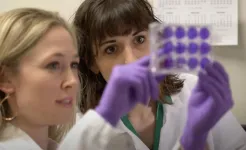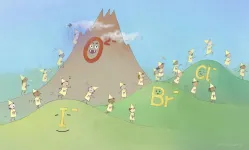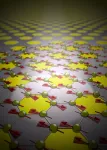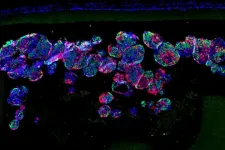(Press-News.org) A team of Colorado State University scientists, led by veterinary postdoctoral fellow Dr. Anna Fagre, has detected Zika virus RNA in free-ranging African bats. RNA, or ribonucleic acid, is a molecule that plays a central role in the function of genes.
According to Fagre, the new research is a first-ever in science. It also marks the first time scientists have published a study on the detection of Zika virus RNA in any free-ranging bat.
The findings have ecological implications and raise questions about how bats are exposed to Zika virus in nature. The study was recently published in Scientific Reports, a journal published by Nature Research.
Fagre, a researcher at CSU's Center for Vector-Borne Infectious Diseases, said while other studies have shown that bats are susceptible to Zika virus in controlled experimental settings, detection of nucleic acid in bats in the wild indicates that they are naturally infected or exposed through the bite of infected mosquitoes.
"This provides more information about the ecology of flaviviruses and suggests that there is still a lot left to learn surrounding the host range of flaviviruses, like Zika virus," she said. Flaviviruses include viruses such as West Nile and dengue and cause several diseases in humans.
CSU Assistant Professor Rebekah Kading, senior author of the study, said she, Fagre and the research team aimed to learn more about potential reservoirs of Zika virus through the project.
The team used 198 samples from bats gathered in the Zika Forest and surrounding areas in Uganda and confirmed Zika virus in four bats representing three species. Samples used in the study date back to 2009 from different parts of Uganda, years prior to the large outbreaks of Zika virus in 2015 to 2017 in North and South Americas.
"We knew that flaviviruses were circulating in bats, and we had serological evidence for that," said Kading. "We wondered: Were bats exposed to the virus or could they have some involvement in transmission of Zika virus?"
The virus detected by the team in the bats was most closely related to the Asian lineage Zika virus, the strain that caused the epidemic in the Americas following outbreaks in Micronesia and French Polynesia. The first detection of the Asian lineage Zika virus in Africa was in late 2016 in Angola and Cape Verde.
"Our positive samples, which are most closely related to the Asian lineage Zika virus, came from bats sampled from 2009 to 2013," said Fagre. "This could mean that the Asian lineage strain of the virus has been present on the African continent longer than we originally thought, or it could mean that there was a fair amount of viral evolution and genomic changes that occurred in African lineage Zika virus that we were not previously aware of."
Fagre said the relatively low prevalence of Zika virus in the bat samples indicates that bats may be incidental hosts of Zika virus infection, rather than amplifying hosts or reservoir hosts.
"Given that these results are from a single cross-sectional study, it would be risky and premature to draw any conclusions about the ecology and epidemiology of this pathogen, based on our study," she said. "Studies like this only tell one part of the story."
The research team also created a unique assay for the study, focusing on a specific molecular component that flaviviruses possess called subgenomic flavivirus RNA, sfRNA. Most scientists that search for evidence of Zika virus infection in humans or animals use PCR, polymerase chain reaction, to identify bits of genomic RNA, the nucleic acid that results in the production of protein, said Fagre.
Kading said her team will continue their research to try and learn more about how long these RNA fragments persist in tissues, which will allow them to approximate when these bats were infected with Zika virus.
"There is always a concern about zoonotic viruses," she said. "The potential for another outbreak is there and it could go quiet for a while. We know that in the Zika forest, where the virus was first found, the virus is in non-human primates. There are still some questions with that as well. I don't think Zika virus has gone away forever."
INFORMATION:
Additional co-authors of the study include Juliette Lewis, Megan Miller, Brian Foy, Tony Schountz and John Anderson (Colorado State University); Eric Mossel (Centers for Disease Control and Prevention, Fort Collins, Colorado); Julius Lutwama, Luke Nyakarahuka and Teddy Nakayiki (Uganda Virus Research Institute); Robert Kityo, Betty Nalikka (Makerere University); Brian Amman, Jonathan Towner and Tara Sealy (CDC, Atlanta).
ITHACA, N.Y. - All fish are not created equal, at least when it comes to nutritional benefits.
This truth has important implications for how declining fish biodiversity can affect human nutrition, according to a computer modeling study led by Cornell and Columbia University researchers.
The study, "Declining Diversity of Wild-Caught Species Puts Dietary Nutrient Supplies at Risk," published May 28 in Science Advances, focused on the Loreto region of the Peruvian Amazon, where inland fisheries provide a critical source of nutrition for the 800,000 inhabitants.
At the same time, the findings apply to fish biodiversity worldwide, as more than 2 billion people depend on fish as their primary source of animal-derived nutrients.
"Investing in safeguarding biodiversity can deliver ...
Researchers at Kyoto University's Institute for Cell-Material Sciences (iCeMS) have developed a new approach to speed up hydrogen atoms moving through a crystal lattice structure at lower temperatures. They reported their findings in the journal Science Advances.
"Improving hydrogen transport in solids could lead to more sustainable sources of energy," says Hiroshi Kageyama of iCeMS who led the study.
Negatively charged hydrogen 'anions' can move very quickly through a solid 'hydride' material, which consists of hydrogen atoms attached to other chemical elements. This system is a promising contender for clean energy, but the fast ...
Stone tools have been made by humans and their ancestors for millions of years. For archaeologists these rocky remnants - lithic artefacts and flakes - are of key importance. Because of their high preservation potential they are among the most common findings in archaeological excavations. Worldwide, numerical dating of these lithic artefacts, especially when they occur as surface findings, remains a major challenge. Usually, stone tools cannot be dated directly, but only when they are embedded in sediment layers together with, for example, organic material. The age of such organic material can be constrained via the radiocarbon technique. If such datable organic remains are ...
Tested on human blood in the lab, the selective nanocapsules could reduce the side effects of a major blood clot dissolving drug, which include bleeding on the brain. If confirmed with animal tests, the nanocapsules could also make the drug more effective at lower doses.
Blood clots, also known as thrombi, are a key cause of strokes and heart attacks which are leading causes of death and ill-health worldwide. They can be treated with a clot dissolving drug called tissue plasminogen activator (tPA) which disrupts clots to clear the blocked blood vessel and re-establish blood ...
Known as nature's own sonar system, echolocation occurs when an animal emits a sound that bounces off objects in the environment, returning echoes that provide information about the surrounding space.
While echolocation is well known in whale or bat species, previous research has also indicated that some blind people may use click-based echolocation to judge spaces and improve their navigation skills.
Equipped with this knowledge, a team of researchers, led by Dr Lore Thaler, of Durham University, UK, delved into the factors that determine how people learn this skill.
Over the course of a 10-week training programme, the team investigated how blindness and age affect learning ...
Atomically thin van der Waals magnets are widely seen as the ultimately compact media for future magnetic data storage and fast data processing. Controlling the magnetic state of these materials in real-time, however, has proven difficult. But now, an international team of researchers led by Delft University of Technology (TU Delft) has managed to use light in order to change the anisotropy of a van der Waals antiferromagnet on demand, paving the way to new, extremely efficient means of data storage.
The thin atomic layers that make up van der Waals magnets may seem extremely fragile, but they can be about 200 times stronger ...
In a six-month study of more than 1,000 Americans, R. Kelly Garrett and Robert Bond found that U.S. conservatives were less able to distinguish truth from falsehoods in 20 viral political news stories that appeared online between January and July 2019. Differences in the political orientation of these stories may help explain this observation, the researchers note, writing that "we find that high-profile true political claims tend to promote issues and candidates favored by liberals, while falsehoods tend to be better for conservatives." Two-thirds (65%) of the high-profile true stories were characterized as benefiting the political left, compared with only 10% that were described as benefiting the political right. Among high-profile false stories, 45.8% were perceived to benefit the ...
Individuals at higher risk of developing pancreatic cancer could be identified earlier using machine learning (ML) techniques which would result in a greater number of patients surviving the disease, suggests a new study published in PLOS ONE.
The study was led by the London School of Hygiene & Tropical Medicine (LSHTM) and funded by the UK charity Pancreatic Cancer Research Fund (PCRF).
It used UK electronic health records for more than 1,000 patients aged 15-99 years who were diagnosed with pancreatic cancer between January 2005 and June 2009.
The researchers examined numerous symptoms and ...
A team of researchers led by diabetes specialists and biomedical engineers at Washington University School of Medicine in St. Louis and Cornell University has demonstrated that, using a miniscule device, they can implant insulin-secreting cells into diabetic mice. Once implanted, the cells secrete insulin in response to blood sugar, reversing diabetes without requiring drugs to suppress the immune system.
The findings are published June 2 in the journal Science Translational Medicine.
"We can take a person's skin or fat cells, make them into stem cells and then grow those stem cells into insulin-secreting cells," said Jeffrey R. Millman, PhD, an associate professor of medicine at Washington ...
A new study reveals that B cells can produce antibodies against the H1N1 influenza virus that also neutralize various other influenza strains, marking a development that could inform research into potential universal flu vaccines. The findings showed that the antibodies targeted two conserved regions of the virus - the cause of the 2009 swine flu pandemic - and that transfers of the antibodies protected mice from lethal infection. The work suggests that vaccines that target the two sites might be able to protect against a broader array of flu strains. Influenza is one of humanity's greatest microbial ...




